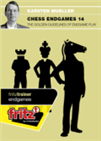The third stage of the game
After six rounds, the participants of the FIDE Chess.com Grand Swiss are finally having a rest on Tuesday. In the open section, five players are tied atop the standings on 4½/6 points, with Maxime Vachier-Lagrave and Krishnan Sasikiran the latest to have joined the leading pack. Among the women, Lei Tingjie reclaimed sole first place by beating Jolanta Zawadzka.
With so much at stage — two spots in the next edition of the Candidates Tournaments — it is not surprising that the players are showing fierce defensive efforts, as every half point is crucial under such competitive conditions. Games often last 5 to 6 hours, with players needing to show good technique in the third stage of the game — the endgame.
Exchanging down into a win
Daniil Dubov and Monika Socko correctly assessed when to give up material to exchange down into a winning technical endgame. Dubov knew his passed pawns on the queenside would grant him the full point after giving up an exchange and swapping the queens.
35.Rxe6 Qxg3 36.fxg3 fxe6 is winning for White even if Black’s rook is the only piece left on the board.
Select an entry from the list to switch between games
Defensive recourses
A material edge does not always guarantee a win in the endgame, as Aryan Tari and Elisabeth Paehtz demonstrated in Riga. While Paehtz defended with bishop (in the right diagonal) against rook, Tari calculated precisely to enter a drawn position with bishop and pawn against a lone king.
 Rules of thumb are the key to everything when you are having to set the correct course in a complex endgame. In this final DVD of his series on the endgame, our endgame specialist introduces you to the most important of these rules of thumb.
Rules of thumb are the key to everything when you are having to set the correct course in a complex endgame. In this final DVD of his series on the endgame, our endgame specialist introduces you to the most important of these rules of thumb.
White gave up his knight with 61.Nc4+, as he knew that after 61...dxc4 62.Kxc4 his king would reach the ‘safe corner’ on a1 in time.
Select an entry from the list to switch between games
Opposite-coloured bishops
Can White win with his far-advanced connected pawns on the kingside?
41.g6 was a good winning attempt by Dariusz Swiercz, but his compatriot Jeffery Xiong demonstrated that he had a fortress in this position.
Knight against bishop
White is a pawn up, but he has a knight against a bishop in a position with action on both flanks of the board.
After 72.Na8 Ke6 (72...Kg7 surprisingly defended), Adhiban managed to regroup his knight and eventually take down his Malagasy opponent, Fy Antenaina Rakotomaharo.
In over 4 hours in front of the camera, Karsten Müller presents to you sensations from the world of endgames - partly reaching far beyond standard techniques and rules of thumb - and rounds off with some cases of with own examples.
Links























